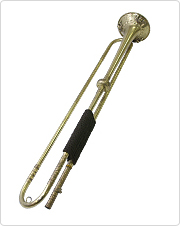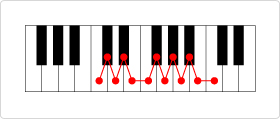The origins of the Trumpet
The invention of the valve
Was the trumpet unable to play scales in olden times?
Early trumpets had a very simple shape, with just a flared bell at the end. The trumpeter could produce a number of different notes by varying his lip movement and the speed of his breath. These notes are known as harmonics and are written on a score as follows:

An early trumpet

An example of harmonics on the trumpet
Do the valves change the length of the tube?
Melodies were played on early trumpets using the run of high-harmonic notes, as shown on the right of the score above. When a trumpeter needed to play songs in different keys, such as C major and G major, he would keep a C major trumpet and a G major trumpet to hand. Looking after all these instruments and carrying them around was very troublesome, however. Accordingly, in around 1810 the valve was invented as a means for easily changing the length of the tube.

A chromatic scale is a scale in which one octave is divided into 12 semitones.
A valve is a device that changes the path taken by the trumpeter's breath. A second tube was added in the middle of the instrument's tube and a valve was attached at the point where they joined. The valve controlled which tube the trumpeter's breath would pass through. It was now easy to change the length of the tube, enabling chromatic scales to be played on the trumpet.
Musical Instrument Guide:Trumpet Contents
Structure
How the Instrument is Made
Choosing an Instrument
Care and Maintenance
Trivia
- Trumpeters in Bach's time alternated between instruments with a variety of ranges when performing
- The keyed trumpet-the fruit of the evolutionary process
- Famous trumpet works - Concertos, part 1
- Famous trumpet works - Concertos, part 2
- Famous trumpet works - Solos
- Is a Flugelhorn a horn? Or a trumpet?
- The highest note a trumpet can produce
- Aida trumpets for the "Grand March"
- The secret of the trumpet's traditional tone: small impurities!?
